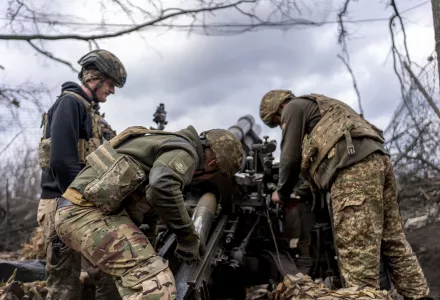Introduction
The recent pause in U.S. intelligence-sharing with Ukraine sent shockwaves through the national security and foreign policy communities. While the Biden administration had been a steadfast provider of intelligence to Kyiv since Russia’s full-scale invasion in 2022, the Trump administration’s decision to halt this support marked a sharp shift in approach. The move, later confirmed by the CIA, was widely seen as a pressure tactic to push Ukraine toward negotiations with Russia.
Now, just days later, intelligence-sharing has reportedly resumed after Ukraine agreed to a 30-day ceasefire.
To understand the deeper implications of this pause—not just for Ukraine’s battlefield capabilities but also for the broader U.S. alliance system—we turned to Calder Walton. As Assistant Director of the Belfer Center’s Intelligence Project and author of Spies, a best-selling exposé on Russian intelligence, Walton is uniquely positioned to analyze the history of U.S.-Ukraine intelligence cooperation and the strategic consequences of its disruption.
In this Q&A, he explores how intelligence-sharing has shaped Ukraine’s war effort, what the temporary suspension signals to allies in Europe, and whether other nations can fill the gap if the U.S. were to step back again.
What are the long-term consequences of this intelligence collaboration, and its suspension, for Ukraine’s national security and future military doctrine?
The big picture is that a pause in U.S. intelligence sharing with Ukraine would be, in the long term, catastrophic for Ukraine's war fighting capabilities. The Ukrainian military relies heavily on U.S. intelligence for targeting both defensive incoming missiles, from Russia, for example, and also proactively, offensively against Russian targets. I agree with the assessment by other commentators that losing this sharing would, in the long term, effectively leave Ukraine blind.
This has been really an extraordinary action for the U.S. government to have taken. It’s not unprecedented for a liaison to be switched off or downgraded, but usually this happens in relation to countries that are not close allies, as Ukraine has been up to this point.
Unfortunately, from my perspective, it feels very much like the Trump administration is in a pay-to-play scenario. Clearly, the overall objective has been to force Ukraine to the negotiation table with Russia, and in that respect it has been successful. The pause in U.S. intel sharing has been a key component by which the Trump administration applied pressure on Ukraine.
The whole thing, from my perspective, has an unedifying sense and feel to it—a transactional, shooting from the hip pay-per-play relationship with a country that, until this point, has been a very close ally. It’s important to stress the US pause in intelligence sharing is not the stuff of an academic seminar about realism and statecraft; it has real-world consequences, with lives literally at stake as Russian missiles fall on cities in Ukraine.
I think it's worth emphasizing that the ramifications of the U.S. intelligence pause will be felt much wider than Ukraine itself. Even sympathetic European countries will be looking at the U.S. and thinking, "How reliable is the United States under the Trump administration as a partner and ally? What if we happen to do something that alienates the Trump administration, and the Trump administration decides to take drastic action and downgrade intel sharing with us?"
The former U.K. Secretary of Defense, Ben Wallace, is on record saying that if he were still Secretary of Defense, he would be asking for an appraisal of UK intelligence and national security establishment vulnerabilities to U.S. manufacturing, arms manufacturing and intelligence-liaison sharing. This is really quite an extraordinary thing to see reported, but it is where we are right now.
When did the U.S.-Ukraine intelligence-sharing relationship begin, and how has it evolved since Russia’s initial invasion in 2014?
Like many aspects of the intelligence world, many of the details of this subject are murky, but it seems clear that the U.S.-Ukraine intel sharing relationship evolved after Ukrainian independence, after the collapse of the Soviet Union in 1991.
Intelligence liaison, generally speaking, is a missing dimension of international relations and diplomacy. These liaisons between closely allied and partnership countries take place out of the public gaze, in secret, but are channels by which sometimes extraordinarily important information is passed from one government to another. Liaisons also take place between adversaries.
It's not an exaggeration to say that this intelligence liaisons between countries constitute a largely unwritten chapter of modern history.
The U.S.-Ukraine intel liaison began in 1991 and evolved as Ukraine decided to give up its nuclear weapons. The U.S.-Ukrainian intel sharing relationship was absolutely essential for a key political moment for Ukraine —as the book by David Hoffman, The Dead Hand and William Perry's recent book, The Button shows— U.S. intelligence was involved integrally in counterproliferation of nuclear weapons in the 1990s.
The U.S.-Ukraine intelligence relationship strengthened in the early 2000s as Putin came into power. The big watershed moment was in 2014, however, with Russia's partial military invasion of Ukraine, into Crimea.
It's difficult to pinpoint, from publicly available information, exactly when the CIA established a station in Kyiv, but it was certainly operating by at least 2014, and has been only strengthened since 2014 and then since Russia's full-scale invasion in 2022. It is not difficult to imagine that CIA officers in Kyiv station have been working hand in glove with their Ukrainian counterparts, fighting Russia, so I imagine the pause in intelligence sharing would have been difficult on a personal level for them.
It's important to say that this is not just a one-way street of U.S. intelligence passing information to Ukraine: the U.S. government has received some reportedly very valuable information from the Ukrainian services. In particular, the Ukrainian intelligence services provided important information on Russia's interference in the 2016 U.S. presidential election.
Has U.S. intelligence influenced Ukraine’s ability to defend against Russian cyber warfare and disinformation campaigns?
There's very much a two-way nexus here. U.S. intelligence has been providing both concrete intelligence and also training to Ukrainian services, but Ukrainian services, with their deep expertise on Russia and Russian malign activities, have also been providing the U.S. intelligence community with valuable information. This would have been taking place in a number of different areas, from human intelligence (namely traditional espionage), to counter disinformation (Ukraine is at the front line of Russian disinformation campaigns) to technical intelligence areas like cyber warfare.
To what extent has Ukraine developed its own intelligence capabilities as a result of this partnership?
Since its independence in 1991, Ukraine has developed some formidable intelligence services, like the Security Service of Ukraine, Sluzhba bezpeky Ukrainy (SBU), and its military intelligence, HUR.
There have been counter espionage scandals in Ukraine, with cases of Russian penetration, and there have been cases of corruption, but certainly since the full-scale invasion of Ukraine by Russia, the services have been on the front line of defending Ukraine against Russia on the battlefield. I should add that in many ways, Ukrainian services are at the front line of a much larger geopolitical clash between western democracy and a darker, autocratic vision for the new world order espoused by Russia.
Can European countries give Ukraine the intelligence support it needs if it no longer receives U.S. intelligence support?
In the news two weeks ago, we saw the brief idea that the U.S. might seek to remove Canada from the Five Eyes Intelligence Sharing Partnership, which caused a lot of confusion.
The Trump administration seems to be trying to disrupt existing intelligence liaison and partnerships. The Five Eyes—the anglophone Commonwealth Intelligence partnership developed after the Second World War between the U.S., UK, Canada, Australia and New Zealand—has been probably the most successful intelligence partnership in history, playing a pivotal a part in helping western governments prevent the Cold War turn into a nuclear World War III.
The key question now is if the Trump administration does disrupt the Five Eyes, and the Five Eyes Alliance has been providing valuable intelligence to Ukraine, can the Four Eyes and European countries, surge their capabilities to provide Ukraine with intelligence in the absence of U.S. intelligence product?
Possible, but doubtful. Within the Five Eyes, it's frequently reported that the U.S. provides about 75% to 80% of the product.
Could European countries surge their capabilities for collection, analysis and dissemination, in the absence of U.S.? It's possible, and fair to say these are exactly the conversations that are going on in places like GCHQ or the Australian Signals Directorate or the Canadian Security Establishment at the moment, and indeed, in non-Five Eyes countries in Europe.
It's simply impossible for outsiders to know about the technical capabilities, but we can say for certain that the U.S. has provided the lion's share of Five Eye's product and intel for Ukraine. And it's not just in ways that we would readily imagine, for example U.S.-based missile systems require U.S. intel streams in order to function. If Ukraine is using armaments that require targeting capabilities, that requires U.S. product, and a non-U.S. product can't simply be sort of slotted into that capability.
This is really a potentially dire situation for Ukraine.
Notwithstanding the resumption of US intelligence sharing with Ukraine (March 11), the fact that the Trump administration did pause it will unfortunately create a situation where even closely allied countries are starting to question whether the U.S. really is a reliable, stable partner that it has been for the defense of Europe for the last 80 years.
Conclusion
As Walton highlights, intelligence cooperation is not just a tactical asset for Ukraine—it is a pillar of its national defense and a key component of Western deterrence against Russian aggression. Beyond Ukraine, a clear message has been sent to allies across Europe: under the Trump administration, U.S. support can no longer be taken for granted.
Looking ahead, the long-term impact of this disruption remains uncertain. While Ukraine has resumed receiving U.S. intelligence, the precedent set by this pause could force Kyiv—and other U.S. allies—to rethink their security strategies and intelligence dependencies. European nations may seek to bolster their own intelligence-sharing networks, but as Walton notes, replicating the scale and sophistication of U.S. capabilities will be an uphill battle.
Whether this moment is an anomaly or a sign of a broader shift in U.S. foreign policy will depend on the decisions made in Washington in the months to come.





